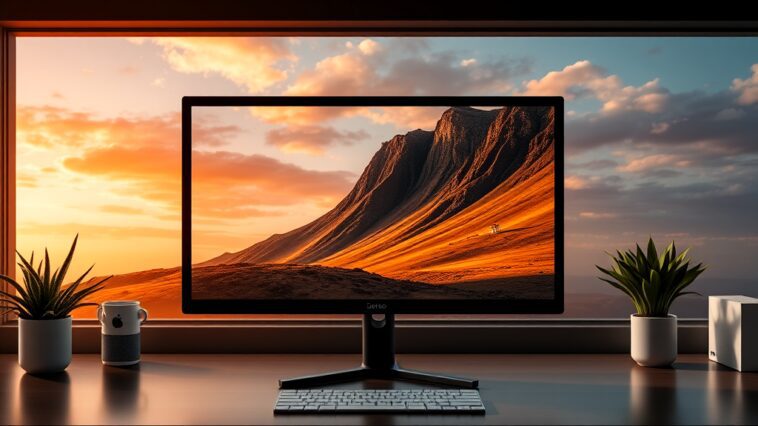Choosing the right display for your needs can feel like a daunting task, especially when you come across numbers like 1920×1080 and 2560×1440. But don’t worry! We’re here to help you break it down and make it easy to understand. Let’s dive into the details of these two popular resolutions and figure out which one is right for you.
Understanding the Basics: What Do These Numbers Mean?
At the core of the discussion is resolution, which refers to the number of pixels that make up the display. Pixels are the tiny dots that create the images you see on your screen. The more pixels there are, the clearer and more detailed the picture will be.
- 1920×1080 (commonly referred to as 1080p or Full HD) has a total of 2,073,600 pixels.
- 2560×1440 (also known as 1440p or WQHD) boasts 3,686,400 pixels.
This means that 2560×1440 has about 78% more pixels than 1920×1080. That’s like comparing a picture made of a few hundred dots to one made of thousands!
Why Resolution Matters
You might be wondering why resolution is such a big deal. Well, it affects everything you do on your display, from watching movies to playing video games.
Everyday Use
For everyday tasks like browsing the internet, checking emails, or streaming videos, both resolutions can get the job done. However, the clarity and detail you experience will differ significantly.
For example:
- 1920×1080 can look perfectly fine for casual browsing or watching videos.
- 2560×1440 allows for sharper images, so if you’re viewing high-resolution content or multitasking with several windows open, you’ll appreciate the extra detail.
Gaming: A Whole New Level
If you’re a gamer, resolution becomes even more crucial. Here’s why:
- 1080p gaming is widely supported and can run smoothly on a wider range of graphics cards, making it accessible for most players.
- 1440p gaming offers a more immersive experience with sharper graphics, but it requires a more powerful graphics card to maintain high frame rates.
Imagine you’re playing a racing game:
- At 1080p, the cars and tracks look good, but you might notice some blurriness when speeding.
- At 1440p, those same cars and tracks look stunningly clear, allowing you to notice the smallest details like tire tread patterns and reflections on the cars.
Pixel Density: The Importance of Clarity
Another aspect to consider is pixel density, which is essentially how many pixels fit into a given area of your screen. This is usually measured in Pixels Per Inch (PPI).
How It Affects Your Viewing Experience
Let’s say you have a 27-inch monitor:
- 1080p on a 27-inch display results in about 81 PPI. This means you might see some pixelation, especially when viewing finer details.
- 1440p on the same 27-inch display gives you about 108 PPI, leading to a much sharper image. This is particularly noticeable when reading text or viewing detailed images.
A Visual Comparison
Think of it this way:
- Imagine looking at a painting from a distance—the colors and shapes are clear, but you can’t see the brush strokes. This is like viewing 1080p.
- Now, imagine stepping closer and noticing every detail in the paint. That’s how 1440p feels!
Practical Examples: When to Choose Which Resolution
Let’s break down a few scenarios to help you understand when to choose 1920×1080 or 2560×1440.
For Students and Professionals
If you’re a student or someone who works from home:
- If you mostly use your computer for tasks like word processing, research, and video conferencing, 1080p is perfectly suitable. It’s cost-effective and still offers good clarity for standard tasks.
- However, if you frequently multitask—like having several documents, spreadsheets, or browsers open at once—then 1440p is definitely worth considering. The extra space means you can see more information at once without scrolling or switching tabs.
For Creatives
For graphic designers or video editors:
- 1440p is the way to go. The added clarity helps you see more details in your work, making it easier to spot imperfections in images or videos. You can also split your workspace more effectively, allowing for a more organized workflow.
For Casual Users
If you’re primarily a casual user:
- For streaming movies or shows, 1080p is often sufficient, especially since most content is available in that resolution. However, if you want to future-proof your setup and watch movies in higher resolutions, 1440p will provide a richer experience.
Gaming Considerations
As mentioned earlier, gaming can significantly influence your choice:
- If you’re playing less demanding games or older titles, 1080p will work seamlessly with less expensive graphics cards.
- For the latest AAA titles, if you want to enjoy beautiful graphics and immersive gameplay, 1440p is the better choice, provided you have the right hardware.
Understanding Your Hardware
Let’s talk about your computer’s hardware because this can determine how well your display performs:
- For 1080p, you can enjoy smooth gameplay and decent graphics with budget-friendly cards.
- For 1440p, you’ll want at least a mid-range graphics card, like an NVIDIA RTX 3060 or an AMD RX 6600 XT, to maintain high frame rates without lag.
Content Quality: Watching Videos
When it comes to watching videos, the resolution of the content you’re viewing plays a huge role:
- Most online content is still predominantly 1080p, so you won’t always notice a massive difference when watching videos on a 1440p monitor.
- However, if you’re watching high-quality Blu-ray movies, they often look stunning on a 1440p display, giving you a more cinematic experience.
Cost Considerations
Budget is a significant factor for many people when deciding on a display. Here’s how the costs generally break down:
- 1080p monitors are typically more affordable and widely available. You can find good options starting at around $150.
- 1440p monitors, while becoming more common, tend to be pricier. You can expect to pay at least $250 to $300 for a decent one.
Making the Right Choice for Your Budget
It’s essential to weigh your priorities:
- If you’re on a tight budget and just need a monitor for basic tasks, 1080p is the way to go.
- If you’re willing to invest a bit more for better graphics, multitasking capabilities, or gaming, then 1440p could be worth the extra cost.
Additional Features to Consider
When shopping for monitors, resolution isn’t the only feature to think about. Here are a few others that can impact your viewing experience:
Refresh Rate
This refers to how many times the display updates per second.
- 60Hz is standard for most monitors, but for gaming, you might want something like 144Hz for smoother gameplay.
Response Time
This is how quickly a pixel can change from one color to another.
- A lower response time (measured in milliseconds) is best for gaming, helping to reduce motion blur.
Panel Type
Different types of panels, such as IPS, TN, and VA, have unique characteristics:
- IPS panels offer better color accuracy and viewing angles, which is great for creative work.
- TN panels are typically cheaper and have faster response times, making them suitable for gaming.
Connectivity Options
Make sure the monitor has the right ports for your needs, like HDMI, DisplayPort, or USB-C. This will ensure compatibility with your computer and other devices.
Real-World Scenarios: The Decision-Making Process
Let’s summarize the thought process for choosing between 1920×1080 and 2560×1440 with a few relatable examples.
Scenario 1: The Student
Imagine you’re a college student who primarily uses your laptop for attending online classes and doing assignments. You occasionally watch movies with friends.
- In this case, 1080p is a solid choice. It’s affordable, and you still get a good viewing experience for lectures and streaming.
Scenario 2: The Gamer
Now, let’s say you’re a gaming enthusiast who loves the latest titles.
- If you have a powerful gaming rig with a capable graphics card, opting for 1440p will provide you with stunning graphics and an immersive experience.
Scenario 3: The Graphic Designer
Consider a graphic designer working on intricate projects.
- Here, 1440p makes perfect sense. The extra detail helps in editing images, and the higher resolution will enhance productivity by allowing more workspace.
Making the Right Choice: A Personal Reflection
Ultimately, the decision comes down to your unique needs and situation. Ask yourself questions like:
- What do I primarily use my computer for?
- How important is graphics quality to me?
- What is my budget?
By reflecting on these aspects, you’ll be better equipped to make a choice that aligns with your lifestyle.
What to Expect Moving Forward
As technology continues to advance, monitors will keep improving. This means resolutions like 4K (3840×2160) are becoming more common, but those come with their own set of requirements and costs.
For now, deciding between 1920×1080 vs 2560×1440 can significantly enhance your experience, whether for work, play, or everyday use. Remember to consider not just the resolution, but all the other features that can make your display truly shine.
So, are you leaning towards a 1080p or 1440p display? The choice is yours, and we hope this guide has helped you better understand your options!



